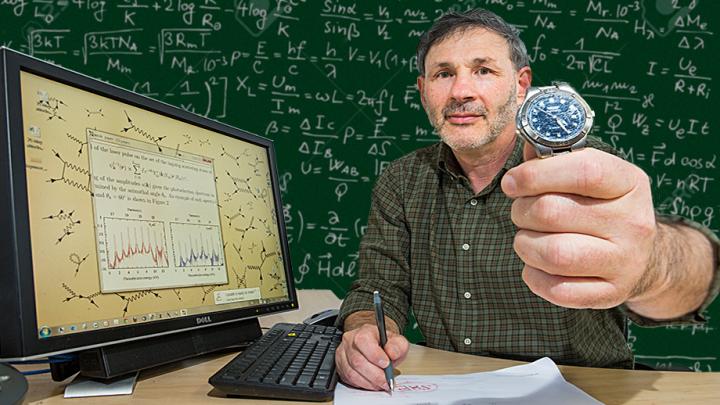Physicists solve quantum tunneling mystery: ANU media release

Professor Anatoli Kheifets' theory has ultrafast physics wrapped up. Credit: Composite image Stuart Hay, ANU
The new theory could lead to faster and smaller electronic components, for which quantum tunneling is a significant factor. It will also lead to a better understanding of diverse areas such as electron microscopy, nuclear fusion and DNA mutations.
“Timescales this short have never been explored before. It's an entirely new world,” said one of the international team, Professor Anatoli Kheifets, from The Australian National University (ANU).
“We have modelled the most delicate processes of nature very accurately.”
At very small scales quantum physics shows that particles such as electrons have wave-like properties – their exact position is not well defined. This means they can occasionally sneak through apparently impenetrable barriers, a phenomenon called quantum tunneling.
Quantum tunneling plays a role in a number of phenomena, such as nuclear fusion in the sun, scanning tunneling microscopy, and flash memory for computers. However, the leakage of particles also limits the miniaturisation of electronic components.
Professor Kheifets and Dr. Igor Ivanov, from the ANU Research School of Physics and Engineering, are members of a team which studied ultrafast experiments at the attosecond scale (10-18 seconds), a field that has developed in the last 15 years.
Until their work, a number of attosecond phenomena could not be adequately explained, such as the time delay when a photon ionised an atom.
“At that timescale the time an electron takes to quantum tunnel out of an atom was thought to be significant. But the mathematics says the time during tunneling is imaginary – a complex number – which we realised meant it must be an instantaneous process,” said Professor Kheifets.
“A very interesting paradox arises, because electron velocity during tunneling may become greater than the speed of light. However, this does not contradict the special theory of relativity, as the tunneling velocity is also imaginary” said Dr Ivanov, who recently took up a position at the Center for Relativistic Laser Science in Korea.
The team's calculations, which were made using the Raijin supercomputer, revealed that the delay in photoionisation originates not from quantum tunneling but from the electric field of the nucleus attracting the escaping electron.
The results give an accurate calibration for future attosecond-scale research, said Professor Kheifets.
“It's a good reference point for future experiments, such as studying proteins unfolding, or speeding up electrons in microchips,” he said.
###
http://www.
Media Contact
All latest news from the category: Physics and Astronomy
This area deals with the fundamental laws and building blocks of nature and how they interact, the properties and the behavior of matter, and research into space and time and their structures.
innovations-report provides in-depth reports and articles on subjects such as astrophysics, laser technologies, nuclear, quantum, particle and solid-state physics, nanotechnologies, planetary research and findings (Mars, Venus) and developments related to the Hubble Telescope.
Newest articles

Webb captures top of iconic horsehead nebula in unprecedented detail
NASA’s James Webb Space Telescope has captured the sharpest infrared images to date of a zoomed-in portion of one of the most distinctive objects in our skies, the Horsehead Nebula….

Cost-effective, high-capacity, and cyclable lithium-ion battery cathodes
Charge-recharge cycling of lithium-superrich iron oxide, a cost-effective and high-capacity cathode for new-generation lithium-ion batteries, can be greatly improved by doping with readily available mineral elements. The energy capacity and…

Novel genetic plant regeneration approach
…without the application of phytohormones. Researchers develop a novel plant regeneration approach by modulating the expression of genes that control plant cell differentiation. For ages now, plants have been the…





















